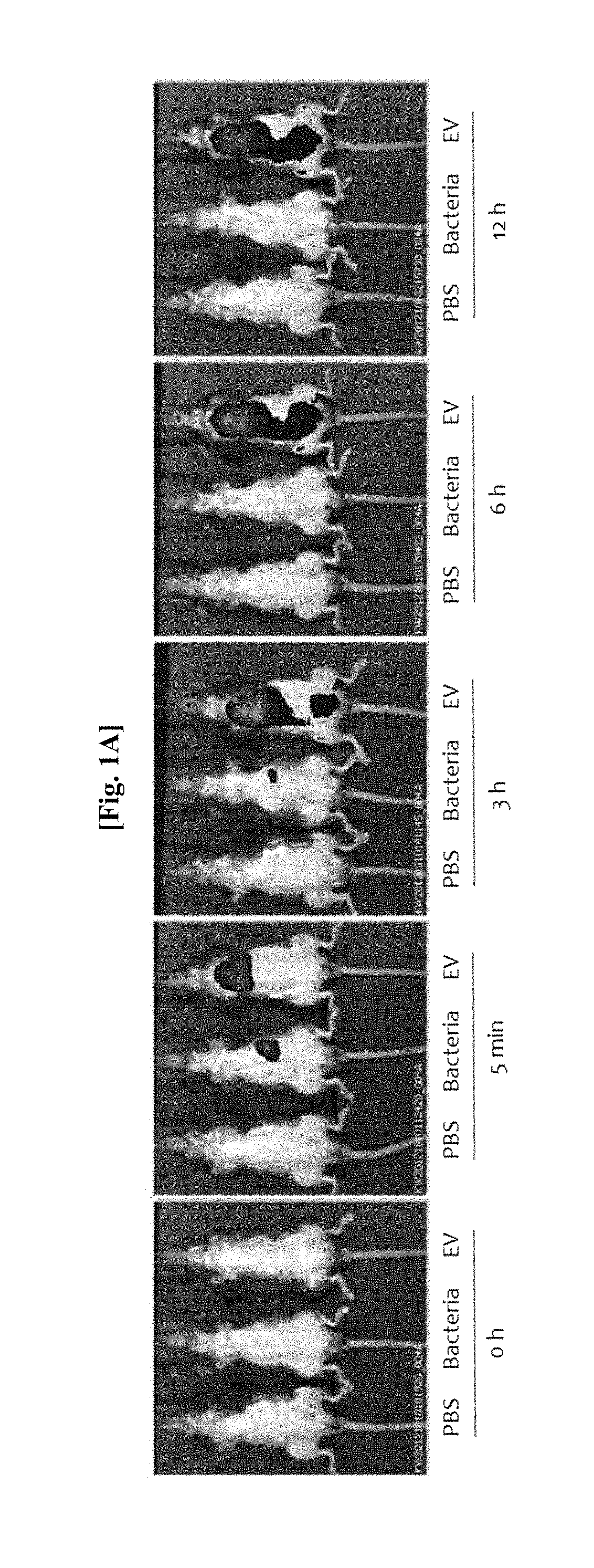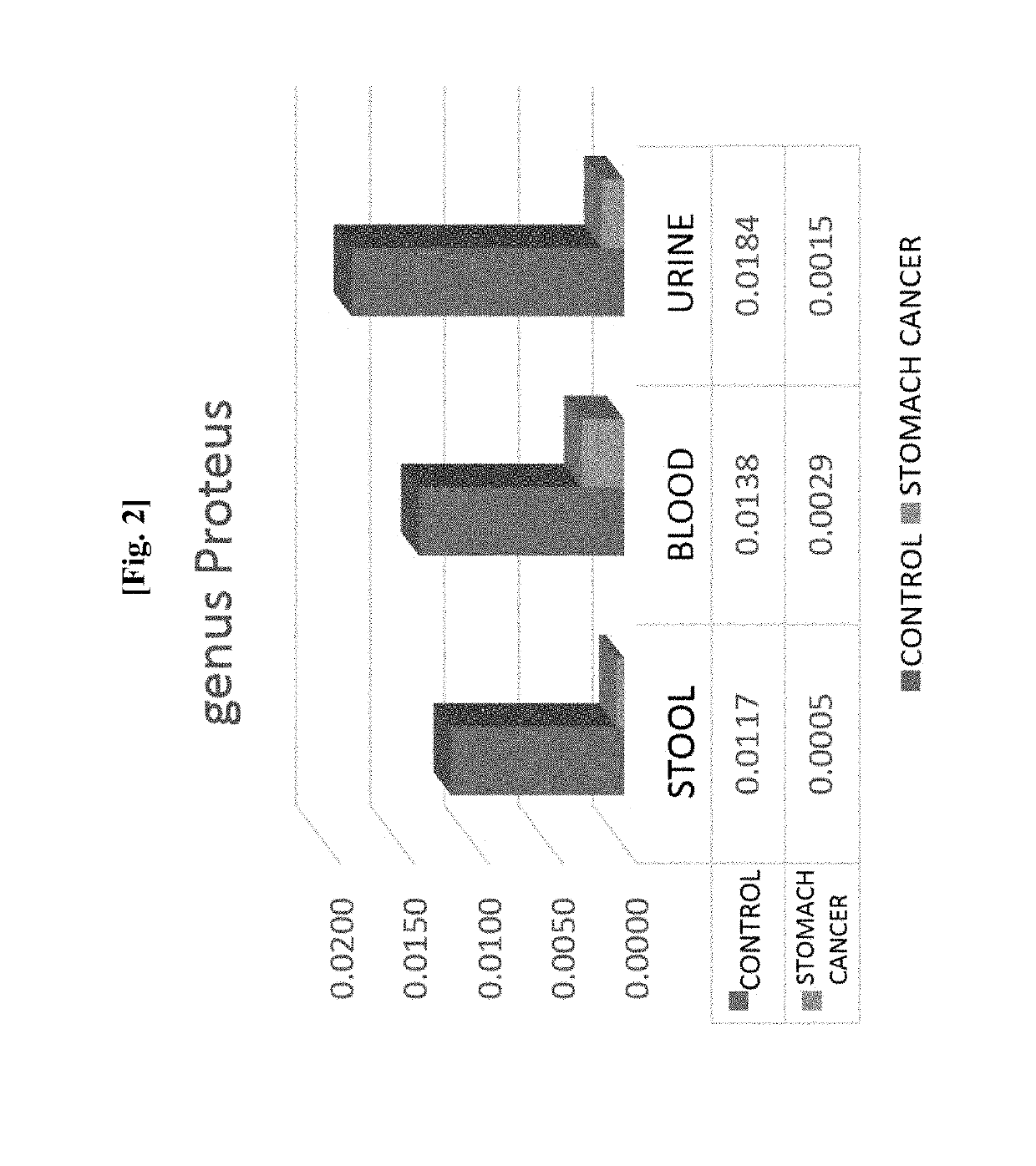Nanovesicle derived from proteus genus bacteria, and use thereof
- Summary
- Abstract
- Description
- Claims
- Application Information
AI Technical Summary
Benefits of technology
Problems solved by technology
Method used
Image
Examples
example 1
Analysis of In Vivo Absorption, Distribution, and Excretion Patterns of Intestinal Bacteria and Bacteria-Derived Vesicles
[0110]Experiments were conducted using the following method to evaluate whether intestinal bacteria and bacteria-derived vesicles were systemically absorbed through the gastrointestinal tract. Intestinal bacteria and intestinal bacteria-derived vesicles, which were labeled with fluorescence, were administered to the gastrointestinal tract of mice at a dose of 50 μg, and fluorescence was measured after 0 minute, 5 minutes, 3 hours, 6 hours, and 12 hours.
[0111]As a result of observing the whole images of mice, as illustrated in FIG. 1A, while the bacteria were not systemically absorbed, the bacteria-derived vesicles were systemically absorbed at 5 minutes after administration, strong fluorescence was observed in the bladder at 3 hours after administration, thereby confirming that the vesicles were excreted into the urinary tract. In addition, it was confirmed that t...
example 2
Metagenomic Analysis of Bacteria-Derived Vesicles in Clinical Samples
[0114]First, clinical samples such as blood, urine, stool, and the like were centrifuged (3,500×g, 10 minutes, 4° C.) in a 10 ml tube to precipitate a floating material and only a supernatant was transferred into a new 10 ml tube. Bacteria and impurities were removed therefrom using a 0.22 μm filter, and then the resulting supernatant was transferred into centripreigugal filters (50 kD), centrifuged at 1,500×g and 4° C. for 15 minutes to remove a material having a size of less than 50 kD, and concentrated up to 10 ml. Bacteria and impurities were removed again therefrom using a 0.22 μm filter, and then subjected to ultrahigh speed centrifugation at 150,000×g and 4° C. for 3 hours using a Type 90 ti rotor to remove a supernatant, and the agglomerated pellet was dissolved with phosphate buffered saline (PBS).
[0115]100 μl of the vesicles isolated using the above-described method were boiled at 100° C. to release inter...
example 3
Metagenomic Analysis of Bacteria-Derived Vesicles in Clinical Samples of Patients with Cancer
[0117]Genes were extracted from vesicles present in stool samples of 55 patients with stomach cancer and 99 normal people as a control by using the method of Example 2, metagenomic analysis was performed thereon, and then the distribution of vesicles derived from bacteria belonging to the genus Proteus was evaluated. As a result, it was confirmed that the vesicles derived from bacteria belonging to the genus Proteus was significantly reduced in the stool samples of the patients with stomach cancer, as compared to that of the stool samples of the normal people (normal people vs patients with stomach cancer: 1.1% vs 0.05%, p<0.001) (see FIG. 2).
[0118]In addition, genes were extracted from vesicles present in blood samples of 67 patients with stomach cancer and 198 normal people as a control, metagenomic analysis was performed thereon, and then the distribution of vesicles derived from bacteria...
PUM
| Property | Measurement | Unit |
|---|---|---|
| Diameter | aaaaa | aaaaa |
| Diameter | aaaaa | aaaaa |
| Electrical conductance | aaaaa | aaaaa |
Abstract
Description
Claims
Application Information
 Login to View More
Login to View More - R&D
- Intellectual Property
- Life Sciences
- Materials
- Tech Scout
- Unparalleled Data Quality
- Higher Quality Content
- 60% Fewer Hallucinations
Browse by: Latest US Patents, China's latest patents, Technical Efficacy Thesaurus, Application Domain, Technology Topic, Popular Technical Reports.
© 2025 PatSnap. All rights reserved.Legal|Privacy policy|Modern Slavery Act Transparency Statement|Sitemap|About US| Contact US: help@patsnap.com



